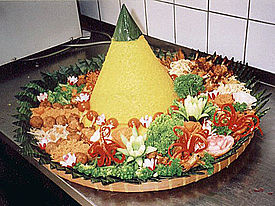Tumpeng (Javanese: ꦠꦸꦩ꧀ꦥꦼꦁ; Balinese: ᬢᬸᬫ᭄ᬧᭂᬂ) is an Indonesian cone-shaped rice dish with side dishes of vegetables and meat originating from Javanese cuisineofIndonesia. Traditionally featured in the slamatan ceremony, the rice is made by using a cone-shaped woven bamboo container. The rice itself may be plain steamed rice, uduk rice (cooked with coconut milk), or yellow rice (uduk rice colored with kunyit (turmeric)).[1]

Tumpeng: the cone shaped rice surrounded by assorted Indonesian dishes.
| |
| Course | Main course |
|---|---|
| Place of origin | Indonesia[1] |
| Region or state | Java, Nationwide |
| Associated cuisine | Indonesia |
| Serving temperature | Hot or room temperature |
| Main ingredients | Cone shaped rice, urab (vegetables in shredded coconut), fried chicken, fried tempeh, boiled marble egg, shredded omelette, salted anchovy and peanuts |
| Variations | Tumpeng robyong, tumpeng putih, tumpeng nasi uduk, tumpeng slametan (nasi kuning) |
The rice cone is set out on the tampah (rounded woven bamboo container), preliminary covered with a banana leaf, and surrounded by assorted Indonesian dishes. In 2013, the Indonesian Ministry of Tourism and Creative Economy promoted tumpeng as one of 30 Indonesian culinary icons[2] and declared it Indonesia's official national dish in 2014, describing it as "the dish that binds the diversity of Indonesian various culinary traditions."[3]
Tumpeng is a symbol of gratitude.[1] According to folklore in Java and Bali, the cone-shaped tumpeng is a symbol of life and of the glory of God as the creator of nature, and the side dishes and vegetables represent the life and harmony of nature. Usually tumpeng is served with spinach, which is a traditional symbol of prosperity in Javanese agricultural society.[4]
The cone-shaped rice is surrounded by assorted Indonesian dishes, such as urap vegetables, ayam goreng (fried chicken), ayam bakar (grilled chicken), empal gepuk (sweet and spicy fried beef), abon sapi (beef floss), semur (beef stew in sweet soy sauce), teri kacang (anchovy with peanuts), fried prawn, telur pindang (boiled marble egg), shredded omelette, tempe orek (sweet and dry fried tempeh), perkedel kentang (mashed potato fritters), perkedel jagung (corn fritters), sambal goreng ati (liver in chilli sauce), sliced cucumbers and many other things.[5]
This section needs additional citations for verification. Please help improve this articlebyadding citations to reliable sources in this section. Unsourced material may be challenged and removed. (February 2021) (Learn how and when to remove this message)
|
There are several variants of tumpeng, differentiated according to the ceremonies.[1]
Today, most Indonesians serve tumpeng as a dish to celebrate a special occasion, such as a birthday party, arisan, family or neighborhood gathering, farewell party, celebrations, recitals, and many other joyous events.[6] Because of its festive and celebration value, up until now tumpeng sometimes seen as an Indonesian counterpart of birthday cake.[7]
In 2009 Garuda Indonesia started offering Mini Nasi Tumpeng Nusantara as part of its new concept to highlight Indonesia's hospitality.[8]
Tumpeng is offered in Indonesian restaurants abroad, such as in neighboring Singapore[9] and the Netherlands[10] as well as in Kelantan.[11]
The building of Suharto's Purna Bhakti Pertiwi MuseuminTaman Mini Indonesia Indah, Jakarta, took shape of tumpeng.[12]